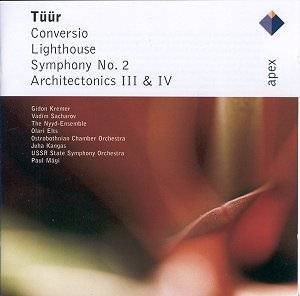Tüür is an Estonian, largely self-taught,
who studied with Rääts and Sumera. In 1979 he founded
a chamber rock group 'In spe' which went on to find chart fame
in Estonia.
Conversio is seriously minimalist
with chaffing Irish style fiddle playing and a ceilidh-stomp rhythm.
Reich's Variations represent a kindred spirit. This is
extremely emphatic music superbly carried off by Kremer taking
a holiday from Schnittke. If Pärt can have his Spiegel
im Spiegel then Tüür can this. Then come the two
Architectonics pieces. These follow tracks associated
with the 1970s ‘ivory tower’ pioneers. III has large
shards of minimalism amid dissolute helpings of gamelan patterning
and archetypical avant-garderie. At first IV ‘messes’,
most creatively, with Mozartian material in Mozartian manner in
much the same way that Schnittke played games with Bachian writing.
This contrasts with later nightmarish synthesiser caterwaulings
and gruff bassoon and saxophone melisma. Lighthouse refers
to the Stravinsky quote about composers who stand as lighthouses
to future generations. Tüür's ‘lighthouse’ is Bach and
although he does not quote there are moments where the manner
is alluded to. It is all fairly modernist stuff but then at 4.08
comes a Tippett-like ecstatic convulsion of string writing. This
resolves into a pattering aggression and lyrical melt-down that
is part-Hovhaness and part-Holst Brook Green! The Symphony
is from the final days of the Soviety ascendancy. It is in
two movements: Vision (6.24) and Process (20.29).
Here there is no sign of minimalism. Rather, in Vision,
we are immersed in the raging unsettling warfare of fanfare and
defiance with a Pendereckian balm in the breath of string writing
and the whisper of woodwind that ends the movement. Process
has a stalwart Sibelian tight ostinato (1.03), a Bartókian
brusqueness risen into a Great Gate of Kiev style climactic
statement (6.03). Tough stuff and difficult to hear as an articulate
continuum. Not without lyrical sustenance and with burgeoning
invention along the way.
May Apex long continue their revival of the Warner
family catalogue. The Finlandia ‘Meet the Composer’ series should
provide rich pickings for them. However my prime recommendation
is of a major piece by Uuno Klami. Klami's Psalmus was
once available on a full price Finlandia. It is an astoundingly
alive and exciting work. How about reisssuing that coupled with
the Kalevala Suite and the superb Cheremissian Fantasy?
Wonderful stuff.
The present collection covers the 1980s and 1990s
and marks the emergence onto the worldstage as enabled by Perestroika.
Rob Barnett
